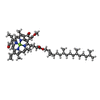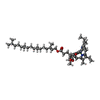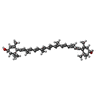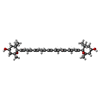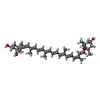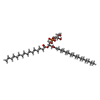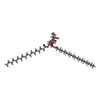[English] 日本語
 Yorodumi
Yorodumi- EMDB-30935: LHCII-2 in the state transition supercomplex PSI-LHCI-LHCII from ... -
+ Open data
Open data
- Basic information
Basic information
| Entry | Database: EMDB / ID: EMD-30935 | |||||||||||||||||||||||||||
|---|---|---|---|---|---|---|---|---|---|---|---|---|---|---|---|---|---|---|---|---|---|---|---|---|---|---|---|---|
| Title | LHCII-2 in the state transition supercomplex PSI-LHCI-LHCII from the double phosphatase mutant pph1;pbcp of Chlamydomonas reinhardti. | |||||||||||||||||||||||||||
 Map data Map data | Local refined map of LHCII-2 in the PSI-LHCI-LHCII supercomplex from pph1;pbcp mutant of Chlamydomonas reinhardtii | |||||||||||||||||||||||||||
 Sample Sample |
| |||||||||||||||||||||||||||
| Function / homology |  Function and homology information Function and homology informationphotosynthesis, light harvesting in photosystem I / photosystem I / photosystem II / chloroplast thylakoid membrane / chlorophyll binding / response to light stimulus Similarity search - Function | |||||||||||||||||||||||||||
| Biological species |   | |||||||||||||||||||||||||||
| Method | single particle reconstruction / cryo EM / Resolution: 3.09 Å | |||||||||||||||||||||||||||
 Authors Authors | Pan XW / Li AJ / Liu ZF / Li M | |||||||||||||||||||||||||||
| Funding support |  China, China,  Japan, 8 items Japan, 8 items
| |||||||||||||||||||||||||||
 Citation Citation |  Journal: Nat Plants / Year: 2021 Journal: Nat Plants / Year: 2021Title: Structural basis of LhcbM5-mediated state transitions in green algae. Authors: Xiaowei Pan / Ryutaro Tokutsu / Anjie Li / Kenji Takizawa / Chihong Song / Kazuyoshi Murata / Tomohito Yamasaki / Zhenfeng Liu / Jun Minagawa / Mei Li /   Abstract: In green algae and plants, state transitions serve as a short-term light-acclimation process in the regulation of the light-harvesting capacity of photosystems I and II (PSI and PSII, respectively). ...In green algae and plants, state transitions serve as a short-term light-acclimation process in the regulation of the light-harvesting capacity of photosystems I and II (PSI and PSII, respectively). During the process, a portion of light-harvesting complex II (LHCII) is phosphorylated, dissociated from PSII and binds with PSI to form the supercomplex PSI-LHCI-LHCII. Here, we report high-resolution structures of PSI-LHCI-LHCII from Chlamydomonas reinhardtii, revealing the mechanism of assembly between the PSI-LHCI complex and two phosphorylated LHCII trimers containing all four types of LhcbM protein. Two specific LhcbM isoforms, namely LhcbM1 and LhcbM5, directly interact with the PSI core through their phosphorylated amino terminal regions. Furthermore, biochemical and functional studies on mutant strains lacking either LhcbM1 or LhcbM5 indicate that only LhcbM5 is indispensable in supercomplex formation. The results unravel the specific interactions and potential excitation energy transfer routes between green algal PSI and two phosphorylated LHCIIs. | |||||||||||||||||||||||||||
| History |
|
- Structure visualization
Structure visualization
| Movie |
 Movie viewer Movie viewer |
|---|---|
| Structure viewer | EM map:  SurfView SurfView Molmil Molmil Jmol/JSmol Jmol/JSmol |
| Supplemental images |
- Downloads & links
Downloads & links
-EMDB archive
| Map data |  emd_30935.map.gz emd_30935.map.gz | 22.6 MB |  EMDB map data format EMDB map data format | |
|---|---|---|---|---|
| Header (meta data) |  emd-30935-v30.xml emd-30935-v30.xml emd-30935.xml emd-30935.xml | 15.7 KB 15.7 KB | Display Display |  EMDB header EMDB header |
| Images |  emd_30935.png emd_30935.png | 335.5 KB | ||
| Archive directory |  http://ftp.pdbj.org/pub/emdb/structures/EMD-30935 http://ftp.pdbj.org/pub/emdb/structures/EMD-30935 ftp://ftp.pdbj.org/pub/emdb/structures/EMD-30935 ftp://ftp.pdbj.org/pub/emdb/structures/EMD-30935 | HTTPS FTP |
-Validation report
| Summary document |  emd_30935_validation.pdf.gz emd_30935_validation.pdf.gz | 305 KB | Display |  EMDB validaton report EMDB validaton report |
|---|---|---|---|---|
| Full document |  emd_30935_full_validation.pdf.gz emd_30935_full_validation.pdf.gz | 304.5 KB | Display | |
| Data in XML |  emd_30935_validation.xml.gz emd_30935_validation.xml.gz | 6.3 KB | Display | |
| Data in CIF |  emd_30935_validation.cif.gz emd_30935_validation.cif.gz | 7.4 KB | Display | |
| Arichive directory |  https://ftp.pdbj.org/pub/emdb/validation_reports/EMD-30935 https://ftp.pdbj.org/pub/emdb/validation_reports/EMD-30935 ftp://ftp.pdbj.org/pub/emdb/validation_reports/EMD-30935 ftp://ftp.pdbj.org/pub/emdb/validation_reports/EMD-30935 | HTTPS FTP |
-Related structure data
| Related structure data |  7e0kMC  7dz7C  7dz8C  7e0hC  7e0iC  7e0jC M: atomic model generated by this map C: citing same article ( |
|---|---|
| Similar structure data |
- Links
Links
| EMDB pages |  EMDB (EBI/PDBe) / EMDB (EBI/PDBe) /  EMDataResource EMDataResource |
|---|---|
| Related items in Molecule of the Month |
- Map
Map
| File |  Download / File: emd_30935.map.gz / Format: CCP4 / Size: 421.9 MB / Type: IMAGE STORED AS FLOATING POINT NUMBER (4 BYTES) Download / File: emd_30935.map.gz / Format: CCP4 / Size: 421.9 MB / Type: IMAGE STORED AS FLOATING POINT NUMBER (4 BYTES) | ||||||||||||||||||||||||||||||||||||||||||||||||||||||||||||
|---|---|---|---|---|---|---|---|---|---|---|---|---|---|---|---|---|---|---|---|---|---|---|---|---|---|---|---|---|---|---|---|---|---|---|---|---|---|---|---|---|---|---|---|---|---|---|---|---|---|---|---|---|---|---|---|---|---|---|---|---|---|
| Annotation | Local refined map of LHCII-2 in the PSI-LHCI-LHCII supercomplex from pph1;pbcp mutant of Chlamydomonas reinhardtii | ||||||||||||||||||||||||||||||||||||||||||||||||||||||||||||
| Projections & slices | Image control
Images are generated by Spider. | ||||||||||||||||||||||||||||||||||||||||||||||||||||||||||||
| Voxel size | X=Y=Z: 1 Å | ||||||||||||||||||||||||||||||||||||||||||||||||||||||||||||
| Density |
| ||||||||||||||||||||||||||||||||||||||||||||||||||||||||||||
| Symmetry | Space group: 1 | ||||||||||||||||||||||||||||||||||||||||||||||||||||||||||||
| Details | EMDB XML:
CCP4 map header:
| ||||||||||||||||||||||||||||||||||||||||||||||||||||||||||||
-Supplemental data
- Sample components
Sample components
+Entire : LHCII-2 in the state transition complex PSI-LHCI-LHCII from pph1;...
+Supramolecule #1: LHCII-2 in the state transition complex PSI-LHCI-LHCII from pph1;...
+Macromolecule #1: Chlorophyll a-b binding protein, chloroplastic
+Macromolecule #2: Chlorophyll a-b binding protein, chloroplastic
+Macromolecule #3: Chlorophyll a-b binding protein, chloroplastic
+Macromolecule #4: CHLOROPHYLL B
+Macromolecule #5: CHLOROPHYLL A
+Macromolecule #6: (3R,3'R,6S)-4,5-DIDEHYDRO-5,6-DIHYDRO-BETA,BETA-CAROTENE-3,3'-DIOL
+Macromolecule #7: (3S,5R,6S,3'S,5'R,6'S)-5,6,5',6'-DIEPOXY-5,6,5',6'- TETRAHYDRO-BE...
+Macromolecule #8: (1R,3R)-6-{(3E,5E,7E,9E,11E,13E,15E,17E)-18-[(1S,4R,6R)-4-HYDROXY...
+Macromolecule #9: 1,2-DIPALMITOYL-PHOSPHATIDYL-GLYCEROLE
+Macromolecule #10: 1,2-DISTEAROYL-MONOGALACTOSYL-DIGLYCERIDE
-Experimental details
-Structure determination
| Method | cryo EM |
|---|---|
 Processing Processing | single particle reconstruction |
| Aggregation state | particle |
- Sample preparation
Sample preparation
| Buffer | pH: 6.5 |
|---|---|
| Vitrification | Cryogen name: ETHANE |
- Electron microscopy
Electron microscopy
| Microscope | FEI TALOS ARCTICA |
|---|---|
| Image recording | Film or detector model: GATAN K2 SUMMIT (4k x 4k) / Average electron dose: 1.5625 e/Å2 |
| Electron beam | Acceleration voltage: 200 kV / Electron source:  FIELD EMISSION GUN FIELD EMISSION GUN |
| Electron optics | Illumination mode: FLOOD BEAM / Imaging mode: BRIGHT FIELD |
| Experimental equipment |  Model: Talos Arctica / Image courtesy: FEI Company |
- Image processing
Image processing
| Final reconstruction | Resolution.type: BY AUTHOR / Resolution: 3.09 Å / Resolution method: FSC 0.143 CUT-OFF / Number images used: 56601 |
|---|---|
| Initial angle assignment | Type: ANGULAR RECONSTITUTION |
| Final angle assignment | Type: ANGULAR RECONSTITUTION |
 Movie
Movie Controller
Controller









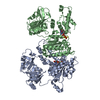
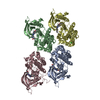
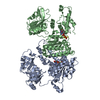
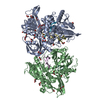
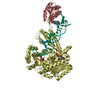
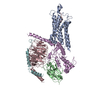

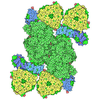
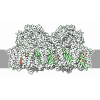
 Z (Sec.)
Z (Sec.) Y (Row.)
Y (Row.) X (Col.)
X (Col.)





















